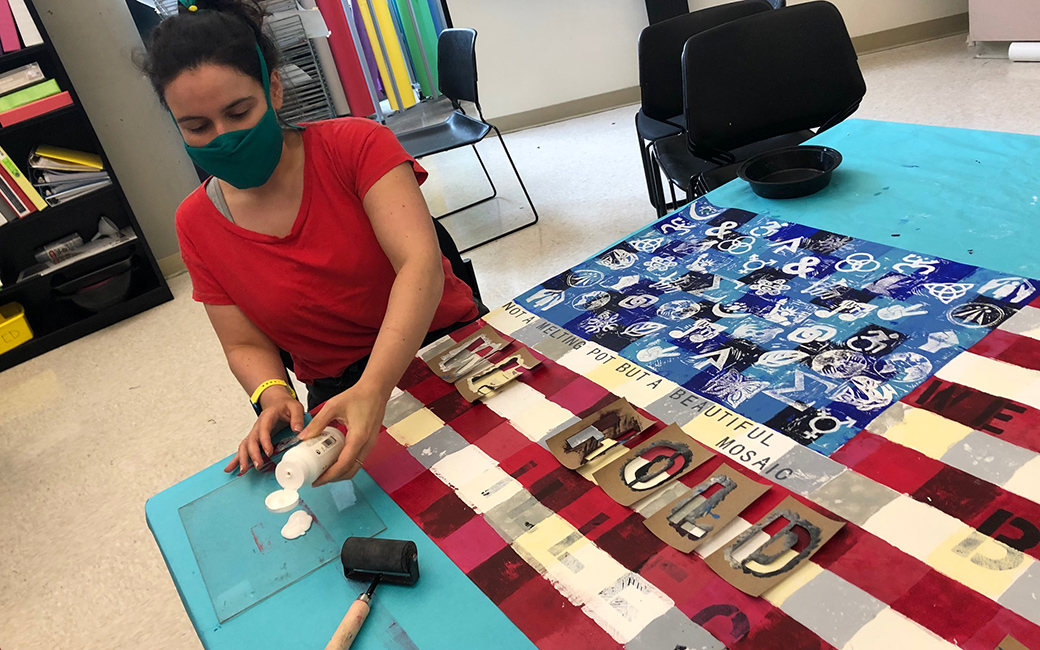‘Unity flag’ by TU artists exhibited alongside final presidential debate
Interdisciplinary arts faculty, student work part of project aiming to foster empathy ahead of U.S. presidential election
By Rebecca Kirkman on October 19, 2020

As viewers tune into the final presidential debate at Belmont University in Nashville on Oct. 22, artwork by artists representing more than 30 states will be on display at the university as part of the “Unity Flag Project: Building Purple Empathy Through the Visual Arts.”
Those artists include Towson University assistant professor Kate Collins, director of the Master of Arts in Interdisciplinary Arts Infusion program (MAIAI), program alumna and adjunct faculty member LaVerne Miers-Bond ’19 and graduate student Ana Maria Economou ’21.
In anticipation of the presidential debate, visual artists from across the U.S. were invited by Belmont’s Watkins College of Art assistant professor Meaghan Brady Nelson to use the American flag and that of their home states as inspiration to create unity flags that promote empathy for bipartisanship. The “Unity Flag Project” is on display in the campus’ Leu Center for the Visual Arts and online at unityflagproject.com.
Over three days in July, Collins, Miers-Bond and Economou worked to create “These Truths,” their contribution to the exhibition.
Responding to the idea of empathy, Collins immediately thought of the refugee and immigrant populations she works closely with through her partnership with the Baltimore City Community College Refugee Youth Project and her service-learning course Youth Allies and Artists Taking Action in Society (YAAAS!).
Read more: Learning in any language
“That’s the first thing that came to mind for me when we talk about empathy,” Collins says. “Shedding light on these populations that are often invisible to huge portions of Americans.”
The country’s founding documents—the Declaration of Independence, Constitution and Bill of Rights—served as additional inspiration for the artists.
“We talked about these well-known phrases that are key things we repeat to ourselves but looking more deeply at those words and what they truly mean,” Economou says, referencing phrases stenciled on the flag’s stripes, including “We hold these truths” and “With liberty and justice for all.”
“As we started putting them down on the flag,” she continues, “it became this interesting puzzle of words that you could string together in different ways to see and understand different messages.”

The work also includes the phrase “Not a melting pot but a beautiful mosaic,” referencing a speech made by former President Jimmy Carter, when he said of the country, “We become not a melting pot but a beautiful mosaic. Different people, different beliefs, different yearnings, different hopes, different dreams.”
The quote provided aesthetic inspiration for the piece too.
“The idea of a beautiful mosaic really felt like it fit,” Collins says. “Then, aesthetically, that gave us a framework to work with the squares that also conveys a quilt.”
Designs made by more than two dozen hand-carved rubber stamps represent the diversity in society, especially groups that are traditionally marginalized.
“I hope that the people who view the flag become aware of what is at stake in this election and the responsibility that we have to protect the diversity that makes our country great,” Miers-Bond says. “I hope that they can see the complexity of the elements and how they work together to make a unified design and that they can extend that understanding to our country and their fellow citizens.”
When asked what role art plays in politics, Collins explains, “We’re in a difficult moment as a country, and it felt like we needed to honor that and recognize that, and use this tiny little platform to say ‘let’s look at these things we’re not looking at closely enough.’”
She adds that art provides a different way to engage the public in challenging or thought-provoking questions. “Not everybody is going to read a 12-page expose, but they can look at an artwork.”
View “These Truths” and more works at the “Unity Flag Project” website through Nov. 20.
This story is one of several related to President Kim Schatzel’s priorities for Towson University: TU Matters to Maryland.